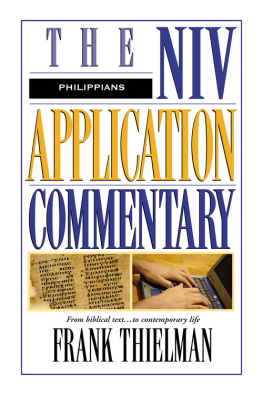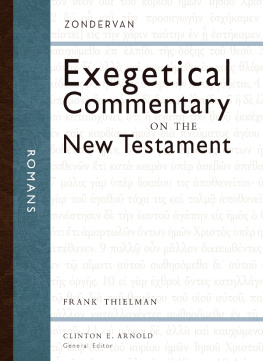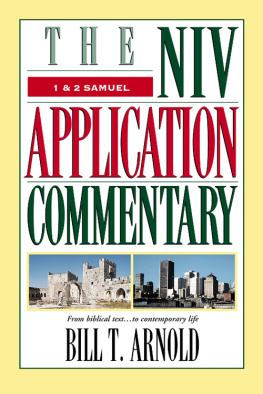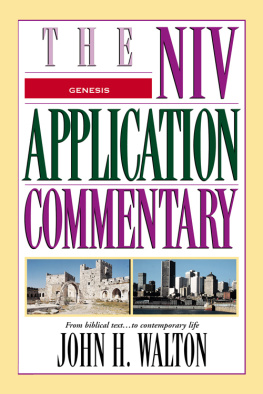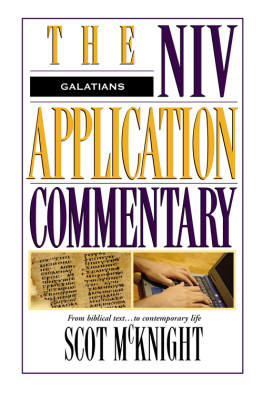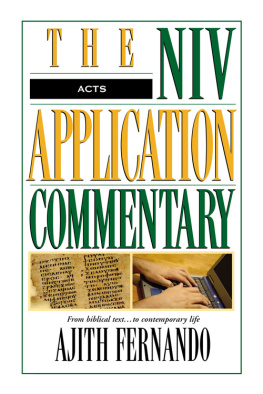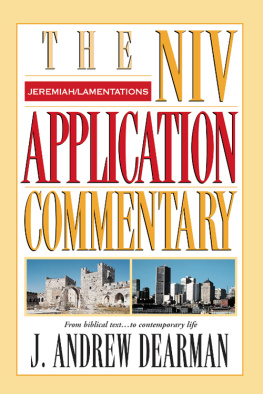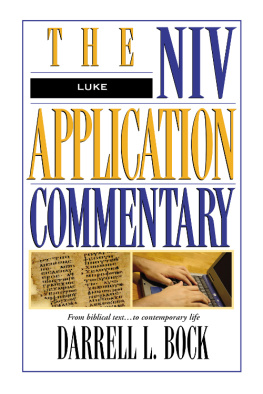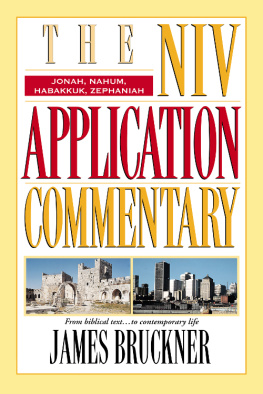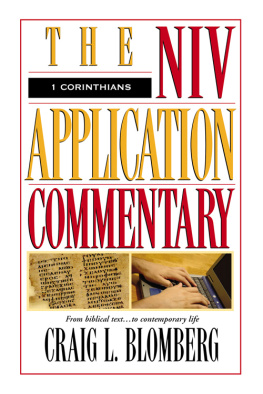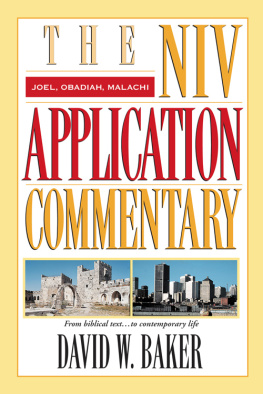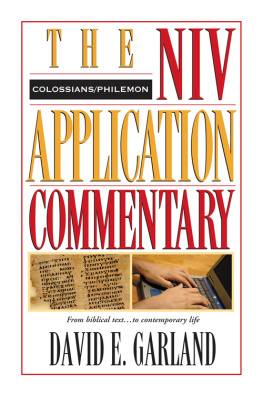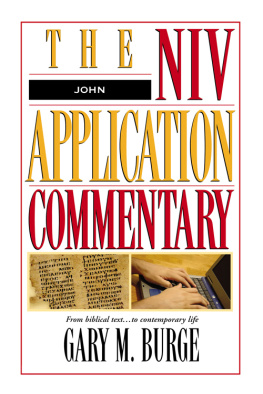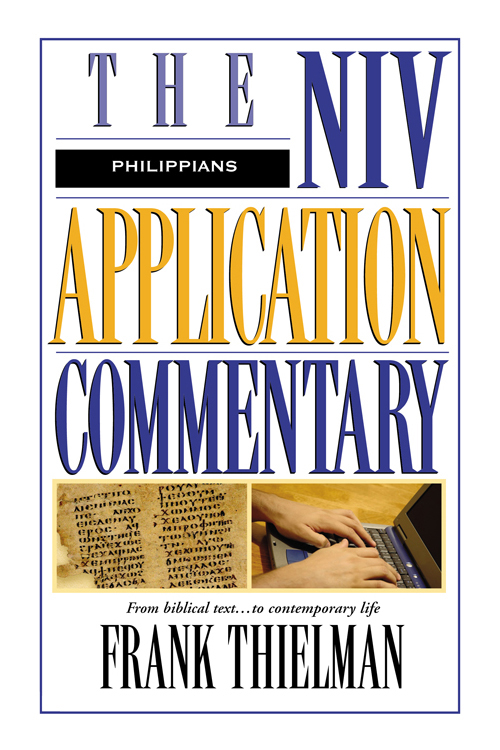
P HILIPPIANS
THE NIV APPLICATION COMMENTARY
From biblical text to contemporary life
FRANK THIELMAN

For my parents,
Calvin and Dorothy Thielman,
servants of Christ Jesus
ZONDERVAN
The NIV Application Commentary: Philippians
Copyright 1995 by Frank Thielman
Requests for information should be addressed to:
Zondervan, 3900 Sparks Dr. SE, Grand Rapids, Michigan 49546
Library of Congress Cataloging-in-Publication Data
Thielman, Frank
Philippians / Frank Thielman.
p. cm.(NIV application commentary)
Includes .
ePub edition November 2014: ISBN 978-0-310-57220-6
ISBN-10: 0-310-49300-5
ISBN-13: 978-0-310-49300-6
1. Bible. N.T. PhilippiansCommentaries. I. Title. II. Series.
BS2705.3.T47 1995
227.606dc 20 95-16836
CIP
All Scripture quotations, unless otherwise indicated, are taken from The Holy Bible, New International Version, NIV. Copyright 1973, 1978, 1984 by Biblica, Inc. Used by permission. All rights reserved worldwide.
All rights reserved. No part of this publication may be reproduced, stored in a retrieval system, or transmitted in any form or by any meanselectronic, mechanical, photocopy, recording, or any otherexcept for brief quotations in printed reviews, without prior permission of the publisher.
Contents
Thank you for purchasing the HarperCollins Christian Publishing eBook version of The NIV Application Commentary.
What is the difference between an eBook and a print book?
eBook versions contain all of the content and supplementary materials found in the original print versions and are optimized for navigation in the various apps and devices used for display. eReaders recognize text as one fluid string and are formatted in a single column. eReaders currently do not support the more complex layout seen in print version books. Therefore, some content may not appear in the same place as in the original print version, but it is structured consistently and uses hyperlinks to navigate between related content.
How do I use the eBook ?
*Important Note: Be sure to consult your device manufacturers Users Guide for device-specific navigation instructions.*
The is the primary navigation anchor to quickly access various parts of the eBook. It is generally formatted in the same order as the original print version and is hyperlinked as follows:
Selecting an entry in the .
How do I navigate the content?
The eBook version of The NIV Application Commentary includes as well as the main book text.
are hyperlinked directly to the content-specific location in the main text.
Select the hyperlinked entry in the article or list to go to its location in the main text.
Select the hyperlinked entry in the main text to go back to the article or list in the or use the devices Back button or function to go back to the last selection.
are marked with small, hyperlinked numbers 1 to access comments and citations.
Select the hyperlinked number in the main text to the corresponding footnote.
Select the hyperlinked number to the left of the to go back to the main text or use the devices Back button or function to go back to the last selection.
citations in the main text.
Select the .
Select the hyperlinked page number 1 to go directly to the citation in the main text.
Use the devices Next Page/Previous Page button or function to scroll through the pages.
Use the devices Back button or function to go back to the last selection
NOTES:
The Bible Translation quoted by the authors in the main , unless otherwise indicated, is taken from the Holy Bible, New International Version. NIV. Copyright 1973, 1978, 1984 by International Bible Society. Used by permission of Zondervan. All rights reserved.
NIV Application Commentary
T HE NIV A PPLICATION C OMMENTARY S ERIES is unique. Most commentaries help us make the journey from our world back to the world of the Bible. They enable us to cross the barriers of time, culture, language, and geography that separate us from the biblical world. Yet they only offer a one-way ticket to the past and assume that we can somehow make the return journey on our own. Once they have explained the original meaning of a book or passage, these commentaries give us little or no help in exploring its contemporary significance. The information they offer is valuable, but the job is only half done.
Recently, a few commentaries have included some contemporary application as one of their goals. Yet that application is often sketchy or moralistic, and some volumes sound more like printed sermons than commentaries.
The primary goal of the NIV Application Commentary Series is to help you with the difficult but vital task of bringing an ancient message into a modern context. The series not only focuses on application as a finished product but also helps you think through the process of moving from the original meaning of a passage to its contemporary significance. These are commentaries, not popular expositions. They are works of reference, not devotional literature.
The format of the series is designed to achieve the goals of the series. Each passage is treated in three sections: Original Meaning, Bridging Contexts, and Contemporary Significance.
Original Meaning
T HIS SECTION HELPS you understand the meaning of the biblical text in its original context. All of the elements of traditional exegesisin concise formare discussed here. These include the historical, literary, and cultural context of the passage. The authors discuss matters related to grammar and syntax and the meaning of biblical words. They also seek to explore the main ideas of the passage and how the biblical author develops those ideas.
After reading this section, you will understand the problems, questions, and concerns of the original audience and how the biblical author addressed those issues. This understanding is foundational to any legitimate application of the text today.
Bridging Contexts
T HIS SECTION BUILDS a bridge between the world of the Bible and the world of today, between the original context and the contemporary context, by focusing on both the timely and timeless aspects of the text.
Gods Word is timely. The authors of Scripture spoke to specific situations, problems, and questions. The author of Joshua encouraged the faith of his original readers by narrating the destruction of Jericho, a seemingly impregnable city, at the hands of an angry warrior God (Josh. 6). Paul warned the Galatians about the consequences of circumcision and the dangers of trying to be justified by law (Gal. 5:25). The author of Hebrews tried to convince his readers that Christ is superior to Moses, the Aaronic priests, and the Old Testament sacrifices. John urged his readers to test the spirits of those who taught a form of incipient Gnosticism (1 John 4:16). In each of these cases, the timely nature of Scripture enables us to hear Gods Word in situations that were concrete rather than abstract.
Yet the timely nature of Scripture also creates problems. Our situations, difficulties, and questions are not always directly related to those faced by the people in the Bible. Therefore, Gods word to them does not always seem relevant to us. For example, when was the last time someone urged you to be circumcised, claiming that it was a necessary part of justification? How many people today care whether Christ is superior to the Aaronic priests? And how can a test designed to expose incipient Gnosticism be of any value in a modern culture?
Next page
